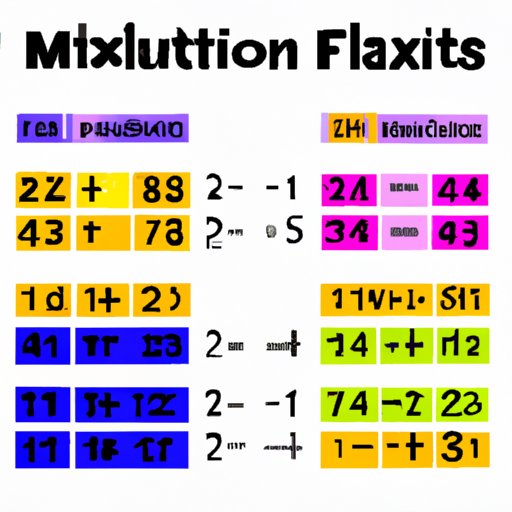
I. Introduction
Mathematics can be an intimidating subject for many people, and fractions are notoriously tricky. But understanding how to multiply fractions with whole numbers is an essential skill that anyone can master with practice and the right guidance. In this comprehensive guide, we will walk you through every step of the process, from the basics to advanced techniques, with plenty of examples and visual aids to help you along the way.
II. “7 Simple Steps to Multiply Fractions with Whole Numbers”
Multiplying fractions with whole numbers may seem daunting at first, but it can actually be broken down into seven simple steps. Follow these steps, and you’ll be a pro at multiplying fractions in no time:
- Step 1: Convert the whole number to a fraction
- Step 2: Multiply the two numerators
- Step 3: Multiply the two denominators
- Step 4: Simplify the product of the numerators and the product of the denominators
- Step 5: Simplify the fraction if possible
- Step 6: Convert an improper fraction to a mixed number (optional)
- Step 7: Double-check your work
Let’s take a closer look at each of these steps.
Step 1: Convert the whole number to a fraction
The first step is to convert the whole number to a fraction. To do this, simply place the whole number over a denominator of 1. For example, if you’re multiplying 2/3 by 4, you would convert 4 to 4/1.
Step 2: Multiply the two numerators
Next, multiply the two numerators together. In the example above, you would multiply 2 and 4 to get 8.
Step 3: Multiply the two denominators
Similarly, multiply the two denominators together. In our example, you would multiply 3 and 1 to get 3.
Step 4: Simplify the product of the numerators and the product of the denominators
Now we have two products: the product of the numerators (8), and the product of the denominators (3). To multiply the fraction and whole number, we need to simplify these products. In this case, there are no common factors for 8 and 3, so we cannot simplify any further.
Step 5: Simplify the fraction if possible
However, we can simplify the resulting fraction if possible. In this example, the fraction is already in its simplest form.
Step 6: Convert an improper fraction to a mixed number (optional)
If your answer is an improper fraction, you may want to convert it to a mixed number. To do this, you divide the numerator by the denominator. The remainder is the new numerator, and the quotient is the whole number. For example, if your answer is 5/3, you would divide 5 by 3 to get 1 with a remainder of 2. Therefore, the answer is 1 2/3.
Step 7: Double-check your work
Always double-check your work to avoid careless mistakes. Make sure that your answer makes sense in the context of the problem.
III. “Master the Art of Multiplying Fractions with Whole Numbers”
Multiplying fractions with whole numbers takes practice, but it’s a skill that anyone can master with effort and the right approach. Here are some tips to help you practice more effectively:
- Understand the basics of fractions and whole numbers before moving on to more complex problems.
- Practice regularly, but don’t cram. It’s better to practice for a short period of time every day than to try to cram several hours of practice into one session.
- Identify your weaknesses and focus on them. If you’re struggling with a particular step, practice that step until you feel confident.
- Use visual aids and examples to help you understand the concepts better.
- Avoid distractions while you practice. Find a quiet place where you can focus without interruptions.
Here are some common mistakes to avoid:
- Forgetting to convert the whole number to a fraction
- Multiplying the numerator and denominator together instead of multiplying the two numerators and two denominators separately
- Forgetting to simplify the resulting fraction if possible
- Not double-checking your work
IV. “Multiplying Fractions with Whole Numbers: A Beginner’s Guide”
If you’re new to fractions and whole numbers, don’t worry. We’ve got you covered. Here’s a step-by-step guide to multiplying fractions with whole numbers:
Step 1: Understand the basics of fractions and whole numbers
Fractions represent a part of a whole. They consist of a numerator (the top number) and a denominator (the bottom number), separated by a line. Whole numbers are simply the numbers 0, 1, 2, 3, and so on. In order to multiply a fraction by a whole number, we must first convert the whole number to a fraction by placing it over a denominator of 1.
Step 2: Find a common denominator
If the two fractions have different denominators, we must find a common denominator before we can multiply them together. To do this, you can either find the least common multiple of the two denominators or simply multiply the two denominators together.
Step 3: Multiply the two numerators
Next, multiply the two numerators together.
Step 4: Multiply the two denominators
Multiply the two denominators together. If you found a common denominator in Step 2, you can skip this step.
Step 5: Simplify the resulting fraction if possible
Finally, simplify the resulting fraction if possible. If there are common factors in the numerator and denominator, you can cancel them out to simplify the fraction.
V. “Explore the Easiest Techniques for Multiplying Fractions by Whole Numbers”
There’s more than one way to multiply fractions with whole numbers. Here are some alternative techniques:
Technique 1: Convert the whole number to an improper fraction
Instead of converting the whole number to a fraction, you can also convert the fraction to an improper fraction and then multiply the two fractions together as usual. For example, if you’re multiplying 4/5 by 3, you could convert 4/5 to 20/5 and then multiply 20/5 by 3.
Technique 2: Divide and conquer
Breaking the whole number down into smaller numbers can make the problem easier to solve. For example, if you’re multiplying 2/3 by 6, you could divide 6 into 2 and 4 and then multiply 2/3 by 2 and then by 4 separately.
Technique 3: Use cross-canceling
If the fractions have common factors, you can cancel them out before you multiply. For example, if you’re multiplying 3/4 by 12, you can cancel out the 4 and the 12 by dividing both by 4. This leaves you with 3/1 or simply 3.
VI. “Fraction Multiplication: How to Multiply Fractions with Whole Numbers Like a Pro”
If you’ve mastered the basics of multiplying fractions with whole numbers, it’s time to take your skills to the next level. Here are some advanced tips and tricks:
- Convert mixed numbers to improper fractions before multiplying.
- Keep track of both the numerator and denominator when simplifying fractions.
- Double-check your work at each step to avoid making mistakes.
- Practice with more complex problems to build your confidence.
Let’s take a look at an example of how to tackle a more complex problem:
What is 5/6 times 2 1/3?
Step 1: Convert the mixed number to an improper fraction. 2 1/3 can be converted to 7/3.
Step 2: Multiply the two numerators. 5/6 times 7/3 equals 35/18.
Step 3: Simplify the resulting fraction. 35/18 can be simplified to 1 17/18.

VII. “Find out How to Multiply Fractions with Whole Numbers in Minutes”
Need to make quick calculations? Here’s how:
- Convert the whole number to a fraction.
- Multiply the numerator and whole number together.
- Simplify the resulting fraction if possible.
Let’s take a look at an example:
What is 2/3 times 4?
Step 1: Convert the whole number to a fraction. 4 can be written as 4/1.
Step 2: Multiply the numerator and whole number together. 2/3 times 4/1 equals 8/3.
Step 3: Simplify the resulting fraction. 8/3 can be converted to 2 2/3.
VIII. “Multiply Fractions with Whole Numbers: Achieve the Perfect Calculation Every Time”
By now, you should be well on your way to mastering the art of multiplying fractions with whole numbers. Here’s what you need to remember:
- Follow the seven simple steps: convert the whole number to a fraction, multiply the two numerators, multiply the two denominators, simplify the products, simplify the fraction if possible, convert an improper fraction to a mixed number (optional), and double-check your work.
- Practice regularly and focus on your weaknesses.
- Avoid common mistakes, such as forgetting to simplify the fraction or double-checking your work.
- Explore alternative techniques, such as dividing and conquering or using cross-canceling, to find what works best for you.
Remember, practice makes perfect. The more you practice, the more confident you will become in your ability to multiply fractions with whole numbers.
IX. Conclusion
Multiplying fractions with whole numbers may seem intimidating at first, but it’s an essential skill that anyone can master with practice and the right guidance. By following our step-by-step guide and exploring the various techniques and tips we’ve provided, you’ll be well on your way to achieving perfect calculations every time.





